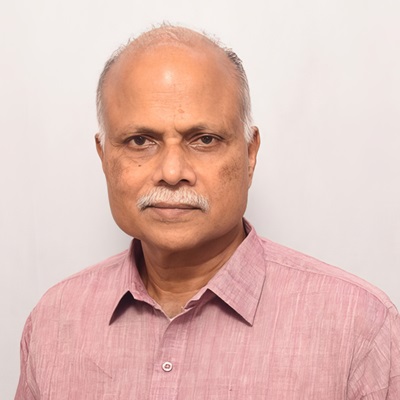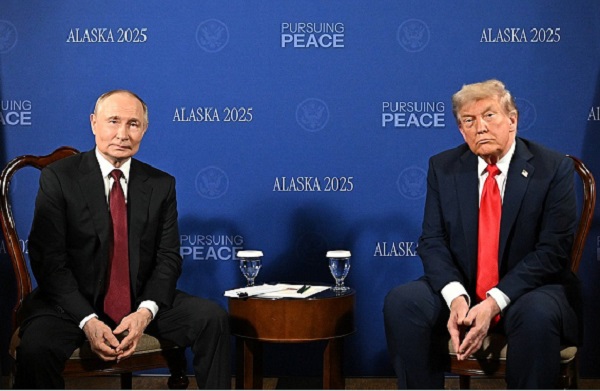.png)

T.K. Arun, ex-Economic Times editor, is a columnist known for incisive analysis of economic and policy matters.
August 18, 2025 at 4:50 AM IST
To say that Putin had Trump for lunch at their Alaska summit that began at 11.30 AM Alaska time and went on for three hours would be to both deride the 72-year-old Russian President’s appetite and overrate his wins.
The outcome most relevant to India is Trump’s seeming reluctance to proceed with secondary sanctions against Russia, which involves additional tariffs on countries buying Russian oil. That would mean that India would face, at the most a tariff of 25% on its exports to the US. But other results of the Alaska summit matter, too.
Trump went into the meeting declaring that he would be very upset if things did not move to a ceasefire in Ukraine after the summit. He came out convinced of the Russian position that rather than a fragile ceasefire, it is better to have a lasting deal on peace that addresses the original reasons for the war. Putin scores.
Trump was bent on levying severe penalties on Russia, in case the summit did not yield a ceasefire. He emerged from the summit denying the need for any stiffer penalties on Russia, or more crucially, the need for secondary sanctions on those who bought Russian oil. Putin scores.
Trump had stoutly resisted any demand that the US guarantee peace in Ukraine after the war ends, saying that the Europeans should look after their backyard. Now, he is ready to commit the US to Ukraine’s peace. If this means that US troops would join European ones to underpin security in post-war Ukraine, it would be a definite win for Zelensky, and no loss to Putin, assuming Russia is content to live with a neutral Ukraine.
Trump had clarity before going into the summit that the war would end only if Ukraine agreed to give up some land to Russia, which Ukraine is dead against. In fact, Ukraine would need to amend its constitution for its leader, Volodymyr Zelensky to give effect to ceding of land in return for peace.
For all its enormous land mass, exaggerated on the conventional maps with their Mercator projection that the world is used to, Russia has only one all-weather naval base: the one in Sevastopol on the Crimean coast. Its Baltic Sea exit is hemmed in by NATO allies. Apart from bases in the Arctic, the Vladivostok base is also prone to freezing over in the winter. Russia’s access to Crimea over land, from Moscow or St Petersburg, runs North-South through the eastern parts of Ukraine now under Russian occupation. Russia has built a bridge to Crimea from the Taman peninsula of Krasnodar Krai in Russia, across the Kerch strait. But Ukraine has blown up parts of the bridge twice in the course of the war, proving the importance for Russia of having uninterrupted land access to its naval base at Sevastopol.
Russia cannot continue to maintain it is a global power without an all-weather naval base that it can supply without fear of disruption by the enemy. That means three things: one, Russia must control Crimea, two, Russia must control the areas through which land access from major Russian centres to Crimea runs, and, three, Ukraine must not join any military alliance hostile to Russia.
It is difficult to imagine Russia agreeing to any peace deal that does not contain these terms. NATO pushed Russia into military action to defend its status as a global power, when it offered membership to Ukraine, and the Maidan revolution threw out a pro-Russian government in 2014. Russia has lost too much blood and treasure for its leader to brook undoing that sacrifice to placate the US and Europe.
Russia is not a systemic rival to the West as the Soviet Union had been. It is a second-rate capitalist economy with a Grade 1 nuclear arsenal, complete with advanced supersonic missiles that leave the earth’s atmosphere, re-enter, and then glide to their destination, making detection hard, and can manoeuvre on the way, when targeted by missile defence systems that do detect them. Europe has little to fear from Russia, any more than it has to fear from Germany, which had initiated the two world wars, in which Russia was an ally of non-fascist Europe.
In fact, in March 2000, when Putin was still acting President, and the presidential election that would elevate him to full presidency was months away, Putin had told BBC interviewer David Frost that Russia would happily join NATO, if Russia were treated as an equal partner. But NATO needed an enemy around which to coalesce, and his offer was spurned.
NATO steadily expanded to Russia’s borders, snapping up not only former members of the Warsaw Pact, but also three former Soviet Republics. When Georgia’s accession to NATO was announced, Putin scotched that move by sending in Russian forces in support of a separatist movement there. In 2014, after the West-backed overthrow of the pro-Moscow government of Ukraine in an uprising, Putin annexed Crimea — local residents rebelled against Kiev, conducted a referendum to demand affiliation to Russia, and Moscow conceded the demand, to recount the formal sequence of events — and aided armed separatism in the Donbas region of eastern Ukraine.
The Dnieper river that runs from North to South through Ukraine not just marks a geographical divide, but also a cultural one. Areas to the east of the Dnieper are more Russian-speaking, and more attuned to the Russian Orthodox Church than the mostly Catholic, Ukrainian-speaking western Ukraine.
Russia has traditionally been part of European culture, home to some of Europe’s finest music, dance, literature and museums. While Russia is properly Eurasian, rather than European in its physical and anthropological expanse, its heart sings as much to Beethoven, the final movement of whose Ninth symphony, dubbed ‘Ode to Joy’, serves as the European Union’s collective anthem, as to a rendering of Kalinka to the strumming of the balalaika.
A Europe that accepts Russia as a peaceful partner, instead of insisting on treating it like a bear gone rogue, would make the world a more secure, stable place. It is conceivable that a Trump-orchestrated end to the Ukraine war would leave Europe with no alternative than to engage with Moscow whose security as a global power is threatened only by its own relative economic and technological weaknesses, and not by a hostile military presence in its backyard.




